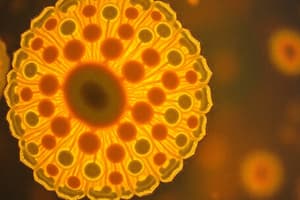Podcast
Questions and Answers
Which two domains consist of prokaryotic cells?
Which two domains consist of prokaryotic cells?
- Fungi
- Archaea (correct)
- Bacteria (correct)
- Eukarya
Describe the difference in the location of prokaryotic and eukaryotic cell DNA.
Describe the difference in the location of prokaryotic and eukaryotic cell DNA.
Eukaryotic cell DNA is found in the nucleus, which is bounded by a double membrane. Prokaryotic cell DNA is found in the nucleoid, a region not membrane-enclosed.
What is the Cell Wall?
What is the Cell Wall?
Rigid structure outside the plasma membrane.
What is the Plasma membrane?
What is the Plasma membrane?
What is a Bacterial chromosome?
What is a Bacterial chromosome?
What is a Nucleoid?
What is a Nucleoid?
What is the Cytoplasm?
What is the Cytoplasm?
What are Flagella?
What are Flagella?
Why are cells so small?
Why are cells so small?
What are microvilli?
What are microvilli?
Describe the nuclear envelope.
Describe the nuclear envelope.
What is the nuclear lamina?
What is the nuclear lamina?
What is the nuclear matrix?
What is the nuclear matrix?
What are chromosomes made of?
What are chromosomes made of?
What are the two components of chromatin?
What are the two components of chromatin?
When do the thin chromatin fibers condense to become distinct chromosomes?
When do the thin chromatin fibers condense to become distinct chromosomes?
Flashcards are hidden until you start studying
Study Notes
Prokaryotic vs. Eukaryotic Cells
- Prokaryotic cells belong to two domains: Bacteria and Archaea.
- Eukaryotic cell DNA is located in the nucleus, which is encased in a double membrane.
- Prokaryotic cell DNA resides in the nucleoid, a non-membrane-enclosed region.
Cell Structures
- The cell wall is a rigid structure that lies outside the plasma membrane.
- The plasma membrane surrounds the cytoplasm, maintaining cellular integrity.
- Bacterial chromosomes carry genetic information in the form of DNA.
- The nucleoid is the area where DNA is housed in prokaryotic cells, without a membrane.
- The cytoplasm is the interior fluid that fills the cell.
- Flagella serve as locomotion organelles in some bacterial species.
Cell Size and Surface Area
- Cells tend to be small to maintain a high surface area-to-volume ratio, facilitating efficient material exchange.
- As a cell grows, its volume increases at a faster rate than its surface area, which could hinder functionality.
Microvilli and Intestinal Cells
- Microvilli are long, thin projections that extend from the cell surface to amplify surface area without increasing cell volume, essential for nutrient absorption in intestinal cells.
Nuclear Structure
- The nuclear envelope encloses the nucleus, separating its contents from the cytoplasm, and consists of two lipid bilayers.
- The nuclear lamina is a network of protein filaments providing structural support to the nuclear envelope.
- The nuclear matrix is composed of protein fibers that are distributed throughout the nucleus, helping organize genetic material effectively.
Chromatin and Chromosomes
- Chromosomes are made of chromatin, which consists of DNA wrapped around proteins.
- The two main components of chromatin are proteins and DNA.
- Thin chromatin fibers condense into distinct chromosomes as cells prepare for division.
Studying That Suits You
Use AI to generate personalized quizzes and flashcards to suit your learning preferences.




